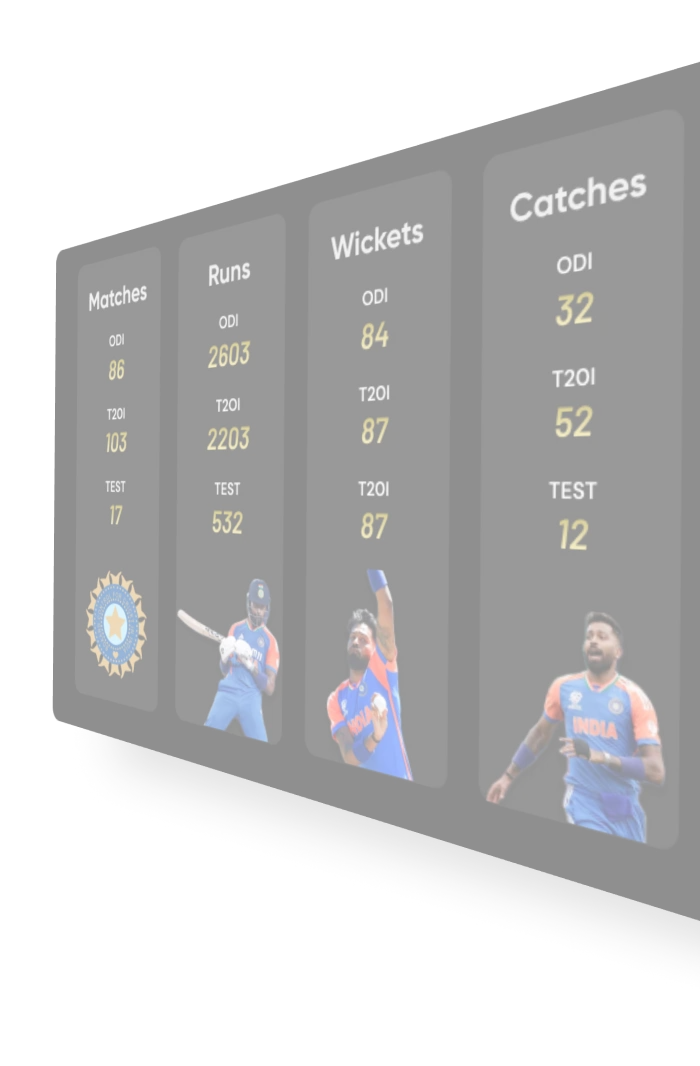
The team of Champions Trophy in 2025 features some of the best players. These players were responsible for their teams’ success in the tournament. Batters like Ibrahim Zadran and Virat Kohli rose to the occasion when the stakes were highest against England and Pakistan, respectively. Apart from them, all-rounders like Azmatullah Omarzai and Mohammad Nabi also played a great role in adding balance to their sides.
Rachin Ravindra is one of the best young players in the Champions Trophy 2025. The Kiwi batter missed the first game against Pakistan owing to a head injury. However, being out of action did not have any effect on Ravindra’s form. Cometh an ICC tournament, cometh the man, as the left-handed made two centuries in the next three games.
Playing against Bangladesh, Ravindra top-scored with a century. His knock came in a difficult situation after the Blackcaps had lost Will Young and Kane Williamson with only 15 runs on the board. He failed against India in the following game, but when he returned to Pakistan for the semifinal, Ravindra made a comeback. He scored another century against South Africa in the knockout game and was named the Player of the Match for his knock. He also took two wickets in the tournament while bowling economical spells.
Ibrahim Zadran won the hearts of every cricket fan with his record-breaking knock against England. The opening batter for Afghanistan scored 216 runs across three innings. However, he did the bulk of the scoring in the match against the Jos Buttler-led side. Zadran scored 177 runs in 146 deliveries, breaking the record for the highest individual score in Champions Trophy history. He also became the player to score a century in the Champions Trophy from his country. It was his innings that allowed Afghanistan to win the clash against England by eight runs and finish above them in the points table from Group B.
Virat Kohli came to the party once again on the big stage. The former Indian was India’s highest run scorer at the Champions Trophy. But it isn’t the volume of runs that makes Virat Kohli the inevitable number three in the team of the tournament. It is the value of the runs he has scored that makes him the very best. Against arch-rivals, Pakistan, after losing Rohit Sharma early in the innings while chasing 242, Kohli stood up. There is no doubt in the minds of the millions of fans he has that Kohli brings his best against the champions from 2017. He scored an unbeaten century against them, but before he reached the milestone, Kohli had sealed the victory for his team.
Against Australia in the semi-final, when the stakes were once again high, Kohli brought out his best. Chasing 265, India had lost both of their opening batters with only 43 runs on the board. However, the master of chases in ODIs showed why he is the greatest asset to have when your team is in pursuit of a tricky target. The 36-year-old scored 84 runs in 98 balls, hitting only five fours. Such is his fitness that even in the hot conditions in Dubai, Kohli scored more than 75% of his runs by running between the wickets. Kohli will be leading the team as well even though he was not the Indian skipper.


Shreyas Iyer was the most consistent batter in the Indian team. He scored the most runs for the Men in Blue in the tournament even after batting out of the top-three. For the past decade, the Indian batting lineup has been dependent on the opening batters and Virat Kohli at number three. But Iyer in the Champions Trophy showed how he has unarguably become India’s best number four ODI batter in recent times.
In five games in the tournament, the right-handed batter scored 243 runs at an average of 48.60. What made him stand apart from the past batters who played at this position was his ability to withstand pressure. He stood up in crucial games including the final. He made 48 runs in the championship match and steadied the ship after India had lost three wickets in quick successions.
Axar Patel has been an underrated performer for India in all three facets of the game. He is not Kohli or Shreyas with the bat. He does not have the variations and mystery that Kuldeep and Chakravarthy do. In the field, he might not be as agile and quick as Ravindra Jadeja. However, the 31-year-old has been the crisis man for India across all three domains. He is among the top wicket-takers in the tournament. He bowled at crucial junctures in the tournament. Against New Zealand, the left-arm spinner was introduced into the attack in the powerplay. In his 10 overs, Patel only conceded 32 runs while taking the wicket of Kane Williamson.
With the bat in hand, Patel might not have the volume of runs on his side, but he has created a huge impact while batting. The left-hander was at his best against New Zealand. It was the toughest challenge that the Indian batters faced in the tournament. After the Men in Blue had lost three wickets with only 30 runs on the board, Patel, along with Shreyas Iyer, shared a 98-run stand. He scored 42 runs in 61 deliveries and smashed three fours and a six


KL Rahul edged Tom Latham for the spot with his consistent performances in the semi-finals and the final. Rahul remained unbeaten in the two crucial games to seal the victory and then, finally, the tournament for India. While he did not make a single fifty in the Champions Trophy and even though Latham scored more runs than him, Rahul made a huge impact in the tournament.
In five games, the Indian batter scored 140 runs and was dismissed only once. Rahul was batting in a challenging position at number six after batting a spot higher in the last couple of years. He transitioned into the role smoothly and struck at a fairly decent rate as well at 97.9.
Azmatullah Omarzai came into this tournament with the tag of being the ICC ODI Cricketer of the Year in 2024. He proved his worth with consistent all-round performances in all three games. He picked up at least a wicket in each match. With the bat in hand, apart from the clash against South Africa, Omarzai perfectly played to his role in the given situations. Against England, Afghanistan needed someone to push the ante, so he played a knock of 41 in 31 deliveries. In his last game against Australia, Omarzai batted defensively as wickets kept falling. In the death, he accelerated nicely to end up with a knock of 67 runs in 63 balls.
With the ball in hand, the right-arm medium pacer picked up seven wickets, including a match-winning five-wicket haul against England. His wickets might have been costlier in comparison to the rest of the bowlers, but Omarzai struck at the most important occasions to help his team claw back into the game every time.


Mitchell Santner is one of the most underrated players in the world. The all-rounder from New Zealand is among the highest wicket-takers in the tournament. Not only has the left-arm spinner picked up regular wickets, but he bowled economically as well.
Santner played a huge role in New Zealand reaching the final of the Champions Trophy. The Kiwi skipper picked up nine wickets in the tournament. He was a consistent bowler throughout the series for the Blackcaps. Him along with Michael Bracewell often applied timely brakes on the run scoring of the opposition batters during the middle overs. Santner bowled his quota of 10 overs in every game and conceded only 240 runs at an economy og 4.80 runs per over.
As another ICC tournament rolled out, Shami once again became the most important bowler for the Indian team. The Indian team coached by Gautam Gambhir surprised many when he along with skipper Rohit decided to go with only three frontline pacers in the their squad. Meanwhile when the Indian cricket team picked only one pacer in the playing 11 in their last three games questions were raised.
Shami was unbothered by these questions as the right-arm pacer led the attack splendidly. Being the sole pacer that too after coming back after a long injury was a tough task for him. However, the veteran pacer picked up nine wickets and was a vital cog in India’s win.
Matt Henry was arguably the best fast bowler in the tournament. The right-arm pacer took 10 wickets for New Zealand in the tournament. Henry started the Champions Trophy with a couple of quiet games but sprung back to action in the final league game against India. It was undoubtedly the best team they had faced up until that stage in the tournament. As the stakes got high, Henry showed his experience with a five-wicket haul. However, his exceptional bowling spell went in vain as the Kiwis went on to lose the game.
Henry was unlucky to miss the final after picking up an injury in the semi-final clash against South Africa. The right-arm pacer still ended up as the highest wicket-taker in the tournament. However, it was not his 10 scalps in the series that showcased his importance. It was the huge gap that left in the bowling lineup of New Zealand when he did not play in the final that that show how crucial Henry was.
Even after missing India’s opening two games against Bangladesh and Pakistan, Varun Chakravarthy makes it into the Team of the Tournament as the premier spinner. The mystery spinner lived up to his tag and proved to be very hard to pick for the opposition batters. In his first game of the tournament, Chakravarthy repaid the faith shown in him by the Indian coaching setup and skipper Rohit Sharma.
He picked up a five-wicket haul against New Zealand in only his second match in the format. His match-winning spell was essential for the Indian team, who were put in to bat for the first time in the tournament. In the semi-final against Australia, Chakravarthy once again showed his magic. Even though he picked up only two wickets, the mystery spinner still played a crucial role in helping India win the match. The 33-year-old dismissed India’s biggest enemy in recent times, Travis Head, with his first ball to him. That wicket alone would have made a lot of India breathe a sigh of relief. He was again crucial in the final match against New Zealand picking up two important wickets.






More Links